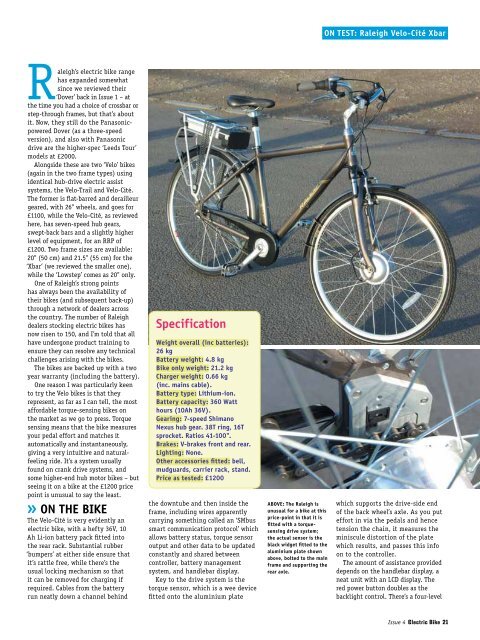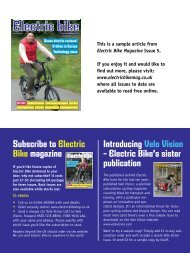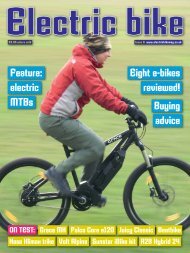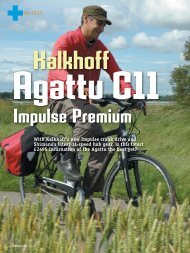Issue Four - Early 2012 - Electric Bike Magazine
Issue Four - Early 2012 - Electric Bike Magazine
Issue Four - Early 2012 - Electric Bike Magazine
You also want an ePaper? Increase the reach of your titles
YUMPU automatically turns print PDFs into web optimized ePapers that Google loves.
Raleigh’s electric bike range<br />
has expanded somewhat<br />
since we reviewed their<br />
‘Dover’ back in <strong>Issue</strong> 1 – at<br />
the time you had a choice of crossbar or<br />
step-through frames, but that’s about<br />
it. Now, they still do the Panasonicpowered<br />
Dover (as a three-speed<br />
version), and also with Panasonic<br />
drive are the higher-spec ‘Leeds Tour’<br />
models at £2000.<br />
Alongside these are two ‘Velo’ bikes<br />
(again in the two frame types) using<br />
identical hub-drive electric assist<br />
systems, the Velo-Trail and Velo-Cité.<br />
The former is fl at-barred and derailleur<br />
geared, with 26" wheels, and goes for<br />
£1100, while the Velo-Cité, as reviewed<br />
here, has seven-speed hub gears,<br />
swept-back bars and a slightly higher<br />
level of equipment, for an RRP of<br />
£1200. Two frame sizes are available:<br />
20" (50 cm) and 21.5" (55 cm) for the<br />
‘Xbar’ (we reviewed the smaller one),<br />
while the ‘Lowstep’ comes as 20" only.<br />
One of Raleigh’s strong points<br />
has always been the availability of<br />
their bikes (and subsequent back-up)<br />
through a network of dealers across<br />
the country. The number of Raleigh<br />
dealers stocking electric bikes has<br />
now risen to 150, and I’m told that all<br />
have undergone product training to<br />
ensure they can resolve any technical<br />
challenges arising with the bikes.<br />
The bikes are backed up with a two<br />
year warranty (including the battery).<br />
One reason I was particularly keen<br />
to try the Velo bikes is that they<br />
represent, as far as I can tell, the most<br />
affordable torque-sensing bikes on<br />
the market as we go to press. Torque<br />
sensing means that the bike measures<br />
your pedal effort and matches it<br />
automatically and instantaneously,<br />
giving a very intuitive and naturalfeeling<br />
ride. It’s a system usually<br />
found on crank drive systems, and<br />
some higher-end hub motor bikes – but<br />
seeing it on a bike at the £1200 price<br />
point is unusual to say the least.<br />
» ON THE BIKE<br />
The Velo-Cité is very evidently an<br />
electric bike, with a hefty 36V, 10<br />
Ah Li-ion battery pack fi tted into<br />
the rear rack. Substantial rubber<br />
‘bumpers’ at either side ensure that<br />
it’s rattle free, while there’s the<br />
usual locking mechanism so that<br />
it can be removed for charging if<br />
required. Cables from the battery<br />
run neatly down a channel behind<br />
Specification<br />
Weight overall (inc batteries):<br />
26 kg<br />
Battery weight: 4.8 kg<br />
<strong>Bike</strong> only weight: 21.2 kg<br />
Charger weight: 0.66 kg<br />
(inc. mains cable).<br />
Battery type: Lithium-ion.<br />
Battery capacity: 360 Watt<br />
hours (10Ah 36V).<br />
Gearing: 7-speed Shimano<br />
Nexus hub gear. 38T ring, 16T<br />
sprocket. Ratios 41-100".<br />
Brakes: V-brakes front and rear.<br />
Lighting: None.<br />
Other accessories fi tted: bell,<br />
mudguards, carrier rack, stand.<br />
Price as tested: £1200<br />
the downtube and then inside the<br />
frame, including wires apparently<br />
carrying something called an ‘SMbus<br />
smart communication protocol’ which<br />
allows battery status, torque sensor<br />
output and other data to be updated<br />
constantly and shared between<br />
controller, battery management<br />
system, and handlebar display.<br />
Key to the drive system is the<br />
torque sensor, which is a wee device<br />
fi tted onto the aluminium plate<br />
ABOVE: The Raleigh is<br />
unusual for a bike at this<br />
price-point in that it is<br />
fi tted with a torquesensing<br />
drive system;<br />
the actual sensor is the<br />
black widget fi tted to the<br />
aluminium plate shown<br />
above, bolted to the main<br />
frame and supporting the<br />
rear axle.<br />
ON TEST: Raleigh ON TEST: Velo-Cité Ezee Xbar Torq<br />
which supports the drive-side end<br />
of the back wheel’s axle. As you put<br />
effort in via the pedals and hence<br />
tension the chain, it measures the<br />
miniscule distortion of the plate<br />
which results, and passes this info<br />
on to the controller.<br />
The amount of assistance provided<br />
depends on the handlebar display, a<br />
neat unit with an LCD display. The<br />
red power button doubles as the<br />
backlight control. There’s a four-level<br />
<strong>Issue</strong> 4 <strong>Electric</strong> <strong>Bike</strong> 21












